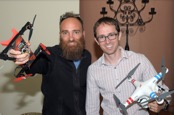A central pedagogical goal at the University of San Diego is to educate Changemakers: individuals who, through empathy, critical thinking, and problem solving, will be prepared to address society’s biggest challenges. While such problems are best addressed by interdisciplinary teams, most of higher education focuses students within disciplinary boundaries. To address this problem we have created a course, Drones for Good, where students from the Shiley-Marcos School of Engineering and the Joan B. Kroc School of Peace Studies come together to design a pro-social drone (Choi-Fitzpatrick 2014). We chose drones because they provide an ideal combination of technical and ethical challenges for students to wrestle with in an interdisciplinary setting. We have twice offered this as a full class, once as a workshop, and plan to offer it regularly moving forward.
Elsewhere we describe the overall structure of the course (Hoople and Choi-Fitzpatrick 2017; Reddy, Hoople, and Choi-Fitzpatrick 2018; Hoople, Choi-Fitzpatrick, and Reddy 2018), here we focus on our efforts to help students develop an entrepreneurial mindset. We agree that “Engineers equipped with this mindset understand the bigger picture, can recognize opportunities, evaluate markets, and learn from mistakes to create value for themselves and others (KEEN 2018).” The inclusion of entrepreneurial content within engineering has gained traction in recent years (Täks et al. 2014; Morgan et al. 2012; Bilán et al. 2005; Antoncic and Hisrich 2003). Our approach is unique in that we situate this entrepreneurial training within an interdisciplinary classroom in order to develop solutions that positively impact society. We thus address revised ABET criteria 2 (applying engineering designs in context) and 4 (consideration of ethical and professional responsibilities).
The foundation of our course is a semester-long project to design a drone that will have a positive impact on society. Students are grouped in teams – 2 engineering students and 2 peace studies students. We start the semester by examining what it means for something to have a positive impact on society. We then have the students build a small drone, ensuring hands-on experience with this technology. During the last phase of the course we introduce entrepreneurial content and have the students develop minimum viable products (Ries 2011), create a business plan using the social model canvas (Burkett 2013), and develop a compelling pitch for a final competition overseen by external judges. This paper is guided by the question “How does our interdisciplinary approach impact student’s ability to develop an entrepreneurial mindset?”
AUTHORS
 |
|
|